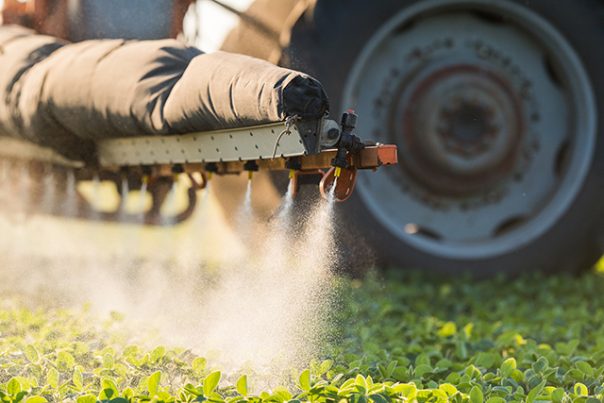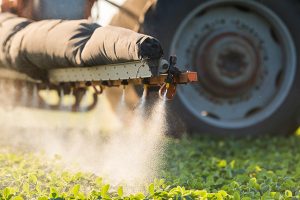
Carbofuran — toxicity, side effects, diseases and environmental impacts
Friday, December 08, 2017 by Janine Acero
http://www.naturalpedia.com/carbofuran-toxicity-side-effects-diseases-and-environmental-impacts.html

Carbofuran is a broad-spectrum carbamate pesticide that kills insects, mites and nematode worms. It is an odorless, white or grayish, crystalline solid, used against soil and foliar pests of field, fruit, vegetable and forest crops.
The United States Environmental Protection Agency (EPA) initiated a ban on all granular formulations of carbofuran in 1994 to protect birds from ingesting carbofuran granules, which resemble grain seeds. The ban is not related to human health concerns.
There is no ban on liquid formulations of carbofuran, but they are classified as Restricted Use Pesticides (RUP).
Carbofuran is the common name for 2,3-dihydro-2,2-dimethylbenzofuran-7-yl methylcarbamate.

List of known side effects
Carbofuran is highly toxic by inhalation and ingestion and moderately toxic by dermal absorption. In addition, it is highly toxic to birds, bees and aquatic life with long-lasting effects.
Carbofuran may cause damage to organs through prolonged or repeated exposure. Death may result at high doses from respiratory system failure associated with carbofuran exposure.
Some of the side effects of carbofuran poisoning include:
- Miosis
- Blurred vision
- Nausea
- Vomiting
- Abdominal cramps
- Sweating
- Diarrhea
- Profuse salivation
- Imbalance
- Breathing difficulty
- Headache
- Lassitude (weakness, exhaustion)
- Muscle twitching
- Incoordination
- Convulsions
- Increased blood pressure
- Incontinence
The EPA has classified carbofuran as “Not Likely to be Carcinogenic to Humans.”
Body systems affected by carbofuran
Carbofuran causes blood cholinesterase inhibition in both humans and animals, affecting central nervous system and peripheral nervous system function.
Items that can contain carbofuran
Carbofuran is used to control insects in a wide variety of field crops, including potatoes, corn and soybeans.
Trade names for carbofuran include Furadan, Bay 70143, Carbodan, Carbosip, Chinofur, Curaterr, D 1221, ENT 27164, Furacarb, Kenafuran, Pillarfuron, Rampart, Nex and Yaltox.
How to avoid carbofuran
Avoid products that use carbofuran as an active ingredient. Handlers, mixers and applicators of carbofuran may be exposed to its fumes in the workplace. The following are some protective measures to avoid any contact with carbofuran:
- Use this material only in well ventilated areas. In case of accidental aspiration, leave the area of contamination and go to an open area with fresh air. Seek medical attention immediately.
- Avoid contact with skin or clothing. Wear a protective suit, chemical-resistant gloves and safety footwear or safety gumboots. Remove any contaminated clothing item carefully. Rinse the contaminated part of the skin with soap and water.
- Do not get this material in your eyes. Wear goggles or a face shield. In case of contact, remove contact lenses (if applicable), then rinse with running water for several minutes. Seek medical help at once.
- Do not eat, drink or smoke near this substance. In case of swallowing any amount of carbofuran, give plenty of water to drink. Refer for medical attention immediately.
- Refer to label instructions and workplace regulations regarding proper handling of equipment before applying chemicals.
Where to learn more
- Chemical Causes of Diabetes: Overeating Is Not the Only Problem
- EPA may approve neurotoxic pesticide that harms children
- Illegal pot farms now creating environmental DISASTER with massive runoff of banned pesticides
- Chemicals.news
- Pesticides.news
Summary
Carbofuran is a broad-spectrum carbamate insecticide, avicide and nematicide.
The EPA banned all granular formulations of carbofuran in 1994 as birds have been killed from ingesting its granules that resemble grain seeds. On the other hand, there is no ban on liquid formulations of carbofuran, but they are classified as Restricted Use Pesticides.
Sources include:
Tagged Under: Tags: carbofuran





